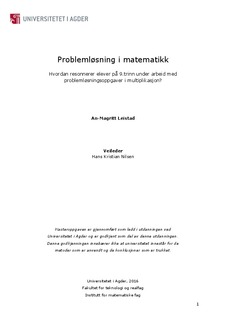| dc.description.abstract | This is a qualitative case study, which highlights students' reasoning in problem solving. The
research question is: How do students in 9th grade reason while working with problem
solving tasks in multiplication. The purpose of this study is to investigate how students in 9th
grade reason while working with problem solving tasks. More knowledge about students'
reasoning in problem solving, can contribute to appropriate use of this in teaching. I defined
two sub-questions that is attempted to be answered in the discussion. The two sub-questions
are:
1. How do students´ reason and which strategies do they use?
2. How do problem solving work in small groups?
The theories that will be presented in this study are sociocultural learning theory, that is the
performed learning theory in this study. Furthermore, it will be presented theory of reasoning
and strategies, problem solving and various models of problem-solving processes, selection of
relevant research and theory of multiplication and the position system.
The empirical material is based on observation of two small groups who work with problem
solving tasks, where the purpose was to study students' reasoning. Furthermore, it was
completed individual semi-structured interviews to supplement the observation. This to gain
insight into the individual student isolated reasoning around problem-solving tasks. The small
groups were divided into a high-performing student group and a low-performing student
group.
The results from the study showed that the students used three different problem-solving
strategies; (1) trial and error strategy, (2) logical reasoning and (3) monitoring strategy and
monitoring questions. The study shows that there are differences between these two student
groups.
The high-performing group showed good reasoning with the problems, and they managed to
some extent to work with these problems like the problem-solving processes are submitted
partly by Polya (1957) and Mason and Davis (1991). They showed that they handled using all
three problem-solving strategies, some of the strategy more appropriate than others. However,
the high-performing students showed a small hint of monitoring strategy. They were
dominated by routine work, and concerned about getting the mathematical solution as fast as
possible.
The low-performing group on the other hand struggled to understand the problem solving
tasks, and they did few logical conclusions. They clearly showed that they were dominated by
routine work, when they were little critical of their solutions, and posed no monitoring
questions around the problems. The low-performing students showed limited use of various
problem-solving strategies. | nb_NO |
